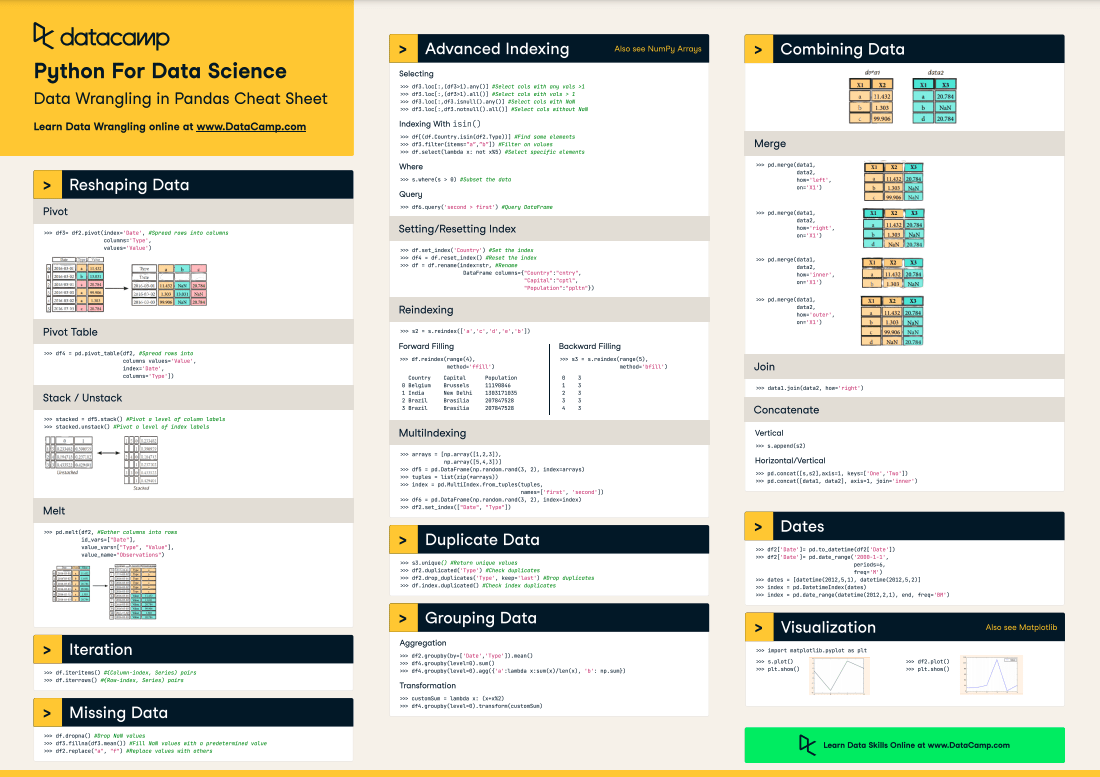The Pandas library is one of the most preferred tools for data scientists to do data manipulation and analysis, next to matplotlib for data visualization and NumPy, the fundamental library for scientific computing in Python on which Pandas was built.
The fast, flexible, and expressive Pandas data structures are designed to make real-world data analysis significantly easier, but this might not be immediately the case for those who are just getting started with it. Exactly because there is so much functionality built into this package that the options are overwhelming.
That's where this Pandas cheat sheet might come in handy.
It's a quick guide through the basics of Pandas that you will need to get started on wrangling your data with Python.
As such, you can use it as a handy reference if you are just beginning their data science journey with Pandas or, for those of you who already haven't started yet, you can just use it as a guide to make it easier to learn about and use it.
Explore Python Pandas for Data Science in Python in this course.
Have this cheat sheet at your fingertips
Download PDFRun and edit the code from this cheat sheet online
Run codeThe Pandas cheat sheet will guide you through the basics of the Pandas library, going from the data structuresto I/O, selection, dropping indices or columns, sorting and ranking, retrieving basic information of the data structures you're working with to applying functions and data alignment.
In short, everything that you need to kickstart your data science learning with Python!
Do you want to learn more? Start the Intermediate Python For Data Science course for free now or try out our Pandas DataFrame tutorial!
Also, don't miss out on our Pandas Data Wrangling cheat sheet or our other data science cheat sheets.
Become a ML Scientist
Python For Data Science Cheat Sheet: Pandas Basics
Use the following import convention:
import pandas as pdPandas Data Structures
Series
A one-dimensional labeled array capable of holding any data type
s = pd.Series([3, -5, 7, 4], index=['a', 'b', 'c', 'd'])| A | 3 |
DataFrame
A two-dimensional labeled data structure with columns of potentially different types
data = {'Country': ['Belgium', 'India', 'Brazil'],
'Capital': ['Brussels', 'New Delhi', 'Brasilia'],
'Population': [11190846, 1303171035, 207847528]}
df = pd.DataFrame(data,columns=['Country', 'Capital', 'Population'])| Country | Capital | Population | |
|---|---|---|---|
| 1 | Belgium | Brussels | 11190846 |
| 2 | India | New Delhi | 1303171035 |
| 3 | Brazil | Brasilia | 207847528 |
Please note that the first column 1,2,3 is the index and Country,Capital,Population are the Columns.
Asking For Help
help(pd.Series.loc)I/O
Read and Write to CSV
pd.read_csv('file.csv', header=None, nrows=5)
df.to_csv('myDataFrame.csv')Read multiple sheets from the same file
xlsx = pd.ExcelFile('file.xls')
df = pd.read_excel(xlsx, 'Sheet1')Read and Write to Excel
pd.read_excel('file.xlsx')
df.to_excel('dir/myDataFrame.xlsx', sheet_name='Sheet1')Read and Write to SQL Query or Database Table
(read_sql()is a convenience wrapper around read_sql_table() and read_sql_query())
from sqlalchemy import create_engine
engine = create_engine('sqlite:///:memory:')
pd.read_sql(SELECT * FROM my_table;, engine)
pd.read_sql_table('my_table', engine)
pd.read_sql_query(SELECT * FROM my_table;', engine)
df.to_sql('myDf', engine)Selection
Getting
Get one element
s['b']
-5Get subset of a DataFrame
df[1:]
Country Capital Population
1 India New Delhi 1303171035
2 Brazil Brasilia 207847528Selecting', Boolean Indexing and Setting
By Position
Select single value by row and and column
df.iloc([0], [0])
'Belgium'
df.iat([0], [0])
'Belgium'By Label
Select single value by row and column labels
df.loc([0], ['Country'])
'Belgium'
df.at([0], ['Country'])
'Belgium'By Label/Position
Select single row of subset of rows
df.ix[2]
Country Brazil
Capital Brasilia
Population 207847528Select a single column of subset of columns
df.ix[:, 'Capital']
0 Brussels
1 New Delhi
2 BrasiliaSelect rows and columns
df.ix[1, 'Capital']
'New Delhi'Boolean Indexing
Series s where value is not >1
s[~(s > 1)]s where value is <-1 or >2
s[(s < -1) | (s > 2)]Use filter to adjust DataFrame
df[df['Population']>1200000000]Setting
Set index a of Series s to 6
s['a'] = 6Dropping
Drop values from rows (axis=0)
s.drop(['a', 'c'])Drop values from columns(axis=1)
df.drop('Country', axis=1)
Sort and Rank
Sort by labels along an axis
df.sort_index()Sort by the values along an axis
df.sort_values(by='Country') Assign ranks to entries
df.rank()Retrieving Series/DataFrame Information
Basic Information
(rows, columns)
df.shapeDescribe index
df.indexDescribe DataFrame columns
df.columnsInfo on DataFrame
df.info()Number of non-NA values
df.count()Summary
Sum of values
df.sum()Cumulative sum of values
df.cumsum()Minimum/maximum values
df.min()/df.max()Minimum/Maximum index value
df.idxmin()/df.idxmax() Summary statistics
df.describe()Mean of values
df.mean()Median of values
df.median()Applying Functions
f = lambda x: x*2Apply function
df.apply(f)Apply function element-wise
df.applynap(f) Internal Data Alignment
NA values are introduced in the indices that don't overlap:
s3 = pd.Series([7, -2, 3], index=['a', 'c', 'd'])
s + s3
a 10.0
b NaN
c 5.0
d 7.0Arithmetic Operations with Fill Methods
You can also do the internal data alignment yourself with the help of the fill methods:
s.add(s3, fill_value=0)
a 10.0
b -5.0
c 5.0
d 7.0
s.sub(s3, fill_value=2)
s.div(s3, fill_value=4)
s.mul(s3, fill_value=3)

